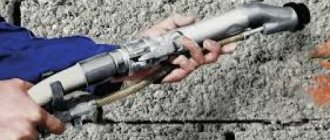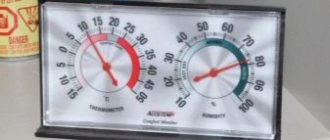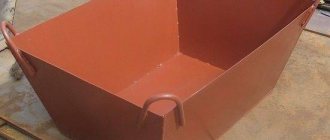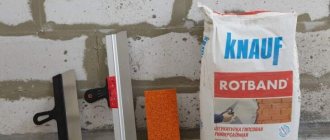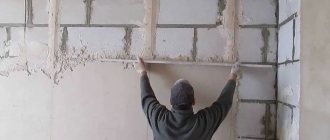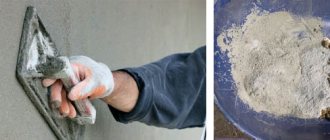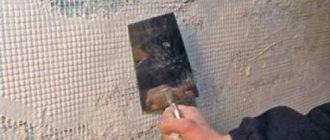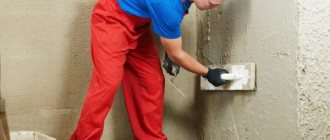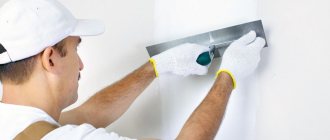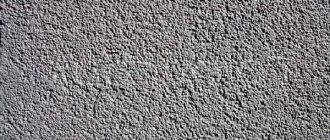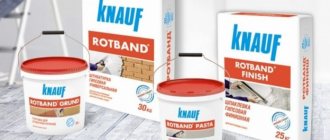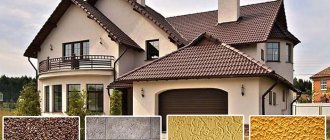Surface preparation
Cleaning
Clean the surface from dirt, dust, peelings and remove any form lubricant residues from the concrete. Remove protrusions and protect metal elements from corrosion. The base must be dry and durable, with a temperature not lower than +5°C.
Padding
To reduce the absorbency of the bases and prevent uneven setting of the plaster mortar, gypsum and cement-lime plasters are treated with KNAUF-Mittelgrund primer diluted with water in a ratio of 1:3 or KNAUF-Multigrund primer. Masonry made of aerated foam concrete blocks, ceramic or silicate bricks is primed using KNAUF-Mittelgrund, diluted with water in a ratio of 1:2 or KNAUF-Multigrund. Dense, smooth, weakly absorbent and non-moisture-absorbing surfaces, for example, concrete, cement plasters, tongue-and-groove and polystyrene foam boards are treated with KNAUF-Betokontakt primer to improve the adhesion (adhesion) of the plaster to the surface. After application, allow the primer to dry: KNAUF-Mittelgrund or KNAUF-Multigrund (6 hours), KNAUF-Betokontakt (12 hours). Avoid dusting the primed surface.
Installation of beacon profiles
Apply K NAUF-Goldband mortar mixture in small portions to the surface of the base after 30 cm, into which press the beacon profiles, aligning them in the same plane. The profile pitch should not exceed the length of the rule.
Installation of protective corner profiles
Apply the KNAUF-Goldband mortar mixture in small portions to the inside of the corner profiles in increments of 30 cm. Place the profiles on the corners in the same plane as the beacon profiles, pressing each from the middle to the edges.
Cement plaster Knauf
Cement-based materials are the most popular. They are easy to use, economical in consumption, and provide high heat and sound insulation.
Cement-based plaster is renowned for its strength and durability, as well as its long lifespan. Even a novice master can handle cement plaster.
Another advantage is that some products in the line can be used for machine application, which simplifies the work. However, there are also disadvantages: cement plaster cannot be used at temperatures below 5 degrees Celsius.
Also, the material necessarily requires a finishing coating - putty.
Adhesive
This type of product is made on the basis of lime and cement. Additives include quartz fillers and chemical mixtures that improve adhesion. Suitable for both machine and manual application.
Diamond
The basis of the plaster material is cement and mineral granules. When applied manually or by machine, it creates a textured coating. It is used for finishing concrete and gypsum surfaces, as well as cement.
Grünband
Contains an additive - polystyrene foam in granules, which gives the composition additional thermal insulation properties. Suitable for working on concrete, brick, as well as for external finishing work (facades and plinths)
Sockelputz
This type of material has increased strength due to the content of fractional sand. Both manual and machine methods are suitable for its application. The coating may contain several layers due to the strength of the plaster composition and good adhesion to the surface. Can be used for both internal and external work.
Unterputz
The plaster of this line is characterized by increased ductility and resistance to moisture. This effect is achieved by adding fractionated sand and various additives to the mixture.
The material is applied both by machine and by hand for interior and exterior decoration. The plaster practically does not shrink and is applied in several layers in stages.
Sevener
The mixture is created on a cement base with the addition of sand and various types of polymers. It has only a manual application method and is intended for finishing and installing insulation.
Consumption of materials
Material consumption is indicated per 1 sq. m of plaster surface with a thickness of 10 mm without taking into account losses.
| Material | Unit measurements | Quantity |
| KNAUF-Goldband | kg | 8,5 |
| KNAUF-Betokontakt | kg | 0,35 |
| KNAUF-Multigrund | kg | 0,2 |
| KNAUF-Mittelgrund | kg | 0,05 |
*One bag of dry mixture (30 kg) is enough to plaster ~ 3.5 m2 of surface.
Advantages of dry mixes from Knauf
Knauf plaster compositions ensure the creation of a smooth and durable surface. This is achieved through the inclusion of mineral components. As a result, after diluting the mixture, a smooth and plastic mass is obtained, which is easily applied in a continuous layer.
The tent practically does not need leveling, since it has no visible roughness or depressions. Thanks to such easy application, even a beginner can plaster large surfaces.
Versatility is another hallmark of the German brand’s dry mixes. Photos of Knauf plaster demonstrate the possibilities of applying it to any substrate:
- made of brick,
- drywall,
- cement,
- concrete.
The only condition that you will have to ensure is met before starting work is the strength of the surface to be plastered. Using gypsum mixtures, it is possible to create both a base and a topcoat, and its final thickness can reach 5 cm.
Knauf plaster is ideal for preparing substrates for wallpapering. It almost immediately allows you to achieve a flat surface, and can become the only point in the preparatory work.
Work order
Preparation of plaster mortar
Pour ~18 liters of clean cold water into a plastic tank per bag (30 kg) of dry mixture and mix with a plaster mixer until a homogeneous, lump-free mass is obtained. If necessary, add water or dry mixture and mix again. During the process of applying the solution to the surface to be plastered, you cannot add dry mixture to the tank! It is not allowed to introduce other components into the solution!
Applying plaster mortar
Apply the prepared plaster solution to a surface 8-50 mm thick within 20-25 minutes after mixing. On the wall - apply it with a trowel or spread it with a plaster falcon from bottom to top, and then level it using the h-rule using zigzag movements. Bases made of CBPB and expanded polystyrene should be plastered with reinforcement over the entire surface with fiberglass mesh with a cell of 5 x 5 mm. Mesh consumption is approximately 1.2 square meters. m per sq. m of surface (including overlap).
Layer thickness
The recommended average thickness of the plaster layer should be 10 mm, the minimum - 5 mm. A single-layer application of the solution in a layer of up to 50 mm is allowed, however, in this case, the drying time of the plaster layer for subsequent finishing increases significantly. To reduce drying time, apply the solution in two steps. First, a layer 35 mm thick is applied, which, while still soft, is “combed” in waves with a plaster comb and only after it has dried, treated with KNAUF-Mittelgrund primer diluted with water in a ratio of 1:3 or KNAUF-Multigrund. After the primer has dried (min. 6 hours), apply a second layer of plaster. The minimum thickness of the plaster layer for gluing ceramic tiles is 10 mm.
Leveling the surface
As soon as the plaster solution begins to set (approximately 45–60 minutes after mixing), level the surface with a metal trapezoidal lath or a wide metal spatula, cutting off excess and filling the recesses. Cut off uneven areas in corners and slopes with a plaster plane. After drying, ceramic tiles can be glued to such a surface using KNAUF-Fliesen glue, having previously treated the surface with a KNAUF-Tiefengrund deep penetration primer. In places where the tiles come into direct contact with water, it is necessary to apply KNAUF-Flachendicht waterproofing. For tiling over waterproofing, adhesives are used: KNAUF-Flizen Plus, KNAUF-Flex, KNAUF-Marble.
Grouting the surface
If the surface is being prepared for painting or wallpapering, then after leveling the surface (after 15 minutes), the plaster must be moistened generously with water and rubbed in a circular motion with a hard sponge or felt grater in order to level out possible unevenness and marks from a trapezoidal lath or wide spatula.
Smoothing the surface
After allowing a short period of time until a matte surface appears, smooth the plaster with a wide spatula or a stainless metal float (trowel) using wide movements. Wallpaper can be glued to such a surface. To achieve a glossy surface, it is necessary to moisten the plaster generously again within 24 hours, but not earlier than 2.5–3 hours after mixing the dry mixture with water, and re-smooth it with a metal float. After this treatment, there is no need to putty the surface of the plaster; it is suitable for painting.
Surface structuring
The surface of the plaster can be structured, i.e. give it a different pattern or texture. To do this, after applying and leveling the mixture, it is usually necessary to roll the not yet hardened surface with a relief roller or give it some kind of structure with a molding tool, for example, a trowel, grout, or a hard brush.
Recommendations
To ensure quick drying of the plaster, it is necessary to ensure good ventilation of the room. Before applying the decorative coating, treat the surface of the plaster with KNAUF-Tiefengrund primer. The water temperature for mixing the dry mixture should be in the range from +5°C to +30°C. Warmer water degrades the water-holding capacity of the plaster mortar and can cause cracks in the plaster. Contaminated containers and tools reduce the time of use of the plaster solution; they should be washed with water immediately after use.
What types of Knauf gypsum plaster are there?
Goldband. It has universal properties and is suitable for both plastering and puttying, due to which the treated surface does not require further finishing and is ready for finishing coating.
The plaster does not contain toxic substances, does not crack even when applied in a thick layer, and does not delaminate. The advantages include economical consumption: it is 2 times less than that of cement analogues.
MP 75
The plaster of this line is created for machine application and is famous for its increased adhesion. Polymer additives are used to create it, making the material suitable for any surface. Using the device in finishing work reduces application time by 3-4 times.
Rotband
Knauf Rotband plaster is a universal plaster mixture. It provides a smooth and even coating without defects thanks to the polymers in the composition. The permissible layer is 5 cm, which can be achieved in one application.
The material is famous for its high adhesion and water-holding ability. After finishing with Rotband plaster, the walls and ceiling do not require additional putty.
Tools
- Plastic tank 50-125 l
- Plaster mixer (N ≥ 800 W)
- Stainless steel trowel
- Sokol plastering
- Rule (h-profile) aluminum
- Trapezoidal aluminum rule or
- wide stainless steel spatula
- Sponge grout
- Metal grater (trowel)
- Plaster comb
- Plaster plane
GYPSUM DRY MIXTURES CAN BE IN DIFFERENT COLOR – FROM WHITE TO GRAY AND EVEN PINK. THIS IS EXPLAINED BY THE PRESENCE OF NATURAL IMPURITIES IN THE GYPSUM STONE. THE COLOR OF THE MIXTURE DOES NOT AFFECT ITS CHARACTERISTICS.
We thank the manufacturer knauf.ru for the information provided.
Gypsum plaster
Finishing materials made on the basis of gypsum are not intended for external work, as they do not withstand temperature changes, humidity and wind, but are very well suited for performing internal repair work.
- Unlike cement plaster, gypsum plaster does not shrink, protects the surface from unevenness and microcracks, and also has less weight.
- Another advantage is its high porosity, due to which the material “breathes” and provides natural ventilation.
Disadvantages include the possibility of deformation due to mechanical damage and intolerance to moisture.
Solution
To prepare the solution, follow these steps:
- pour the plaster into the prepared container, pour liquid into it (approximately 0.5 liters of water per 1 kg of dry plaster material);
- You must first study the information specified in the instructions, because the proportions are sometimes indicated differently;
- Then you will need to mix the material until it becomes homogeneous. This can be done using a drill with an attachment or a construction mixer;
- then wait a few minutes, the plaster should stand for a while;
- Stir the material again and it will be ready for use.
It will be necessary to use the plaster composition for half an hour, then it will become unusable.
In order not to harm the plaster, you should not mix it with any additional ingredients. If everything is done correctly, the quality of the mixture will be very high even without various improvements.
Disadvantages of the Knauf mixture
There are no ideal building materials. The downside to Knauf plaster is its price. But it is compensated by excellent quality, and where it would be necessary to apply several layers for a better result, Knauf can handle it in fewer passes. There is also no need to additionally putty the surface.
Among the shortcomings, some craftsmen tend to note shrinkage, which in some cases leads to the formation of cracks. The manufacturer attributes this effect to a violation of the technology for applying the composition.
Sometimes, altered proportions when mixed with water lead to deformation of the base due to shrinkage. It is important to never ignore the recommendations on the packaging.
Privacy Policy
General provisions
Some objects posted on the site are the intellectual property of the company “Building materials online store DOM Dream”. The use of such objects is established by the current legislation of the Russian Federation.
On the website “Building materials online store DOM Dream” there are links that allow you to go to other sites. The company “Building materials online store DOM Dream” is not responsible for the information published on these sites and provides links to them only to ensure convenience for visitors to its site.
Personal information and security
The company “Building materials online store DOM Dream” guarantees that no information received from you will ever be provided to third parties under any circumstances, except as provided for by the current legislation of the Russian Federation.
In certain circumstances, the company “Building materials online store DOM Dream” may ask you to register and provide personal information. The information provided is used solely for official purposes, as well as to provide access to special information.
Personal information can be changed, updated or deleted at any time under “Account” > “Profile”.
In order to provide you with certain types of information, the company “Building materials online store DOM Dream”, with your explicit consent, may send information messages to the email address specified during registration. At any time you can change the subject of such mailings or refuse it.
Like many other sites, “Building materials online store DOM Dream” uses cookie technology, which can be used to promote our product and measure the effectiveness of advertising. In addition, with the help of this technology, “Building materials online store DOM Dream” is configured to work personally with you. In particular, without this technology it is impossible to work with authorization in the control panel.
The information on this website is for informational purposes only and is subject to any changes without any prior notice.
To opt out of further communications with our company, change or delete your personal information, write to us via the feedback form
A little history
Until the 60s of the last century, all gypsum plaster solutions were mixed directly on the construction site in proportions determined by the craftsmen “by eye” based on their own experience. Moreover, due to the property of gypsum to set almost instantly, batches were made in very small portions in order to have time to work them out in a short period of time. This affected both the speed of work and its quality, since the mixture quickly lost its plasticity and was poorly distributed over the surface.
The situation changed after the invention of a substance that, when added to the gypsum mixture, slows down its setting. It was named Alenal after the inventor.
And in 1962, the Knauf company, at its production facility located in West Germany, began producing Rotband dry mixes, the consumption of which for each batch increased significantly compared to the previous technology, and it became easier to apply the finished solution. The company's technologists have developed a precise recipe for mixing the mixture with exact proportions of dry matter and water, holding time and application.
Knauf plant for the production of building mixtures Source static.360tv.ru
Knauf products “came” to Russia and the CIS countries in 1993. It is produced in the Moscow region (Krasnogorsk), in St. Petersburg, Chelyabinsk and Kuban, as well as in Moldova.
An effective solution.
Moisture-resistant plaster for the Knauf bathroom is used to prepare surfaces for further finishing. Ceramic tiles and other materials can be glued to it. You can cover it on top with a layer of decorative plaster. Quite a lot of such compositions are offered today. An important property of moisture-resistant mixtures for plastering surfaces is high plasticity. This allows you to make very even angles with it. The coating formed using this material is very smooth. If desired, it can be painted almost immediately after application.
Fugenfueller Hydro
The composition is almost identical to the previous one, with the difference that it is used in rooms with high humidity. For this reason, mixtures labeled Hydro are used with moisture-resistant drywall.
The ready-made solution is suitable for fixing gypsum board sheets and sealing seams.
Sold in bags of 25 kg, cost from 750 rubles (price in Moscow).
How to plaster bathroom walls
The time for plastering work is during preparation for cosmetic repairs or immediately upon completion of construction. This work is not very difficult, but it will not be easy for an inexperienced person to cope with it.
Typically, a cement-sand mortar is used as a plaster mixture; the use of such a material requires knowledge of the exact recipe for preparing the mortar and adherence to the technology for mixing it.
Somewhat more expensive, but much more reliable, will be the use of a ready-made mixture produced by an industrial method - waterproof putty for the bathroom. As a budget option, we can note the use of prawning, a mixture consisting of cement, lime and sand. Gartsovka can be applied in a thick layer, up to 5 cm, but be sure to use a plaster mesh. A thick layer of the mixture will take about a month to dry completely, but it should be taken into account that the solution acquires sufficient strength only after 25-27 days.
Special Recommendations
Frost and too rapid drying are contraindicated for freshly applied Knauf Diamant plaster mixture. As reviews indicate, this leads to structural stress. If unexpected precipitation begins or, conversely, it becomes very hot, you need to cover the treated surface using a tarpaulin or film and do not open it until it is completely dry.
Knauf Diamant decorative plaster can be applied when the main plaster layer has dried well. The instructions prohibit its contact with a wet surface. In addition, before applying Knauf Diamant decorative plaster, the surface must be treated with an undiluted primer.
To prevent weather or other factors from causing color differences, try to complete all the work within one day, avoiding long breaks. If a color difference does arise, then the well-dried plaster can be coated with a special paint of a similar color. According to reviews, this gives good results. Don't forget to wash all used tools after use.
Material consumption
Many people are concerned with the question of how to carry out the work economically and beautifully. It is not at all difficult to calculate the consumption of KNAUF Diamant decorative plaster. If you do not take into account losses, then for one square meter of surface you need 3.8 kg of mixture. According to reviews, the consumption of one bag is suitable for processing 6.5 square meters of surface. Decorative plaster KNAUF Diamond is considered a very economical finishing material. It has a relatively low price and low product consumption.
Decorative plaster can be packaged in three-layer paper bags. It must be stored in dry areas. It cannot be used after the expiration of the shelf life, which is six months, provided that the packaging is not damaged. The weight of one bag is twenty-five kilograms.
So that your home does not greet you with dull, faceless walls, turn it into an original and cozy home with the help of KNAUF Diamant decorative plaster. She will help you create any fantastic design for both interior and facade.
Negative Features
For high quality products you have to pay a high price. Knauf gypsum plaster is considered an expensive product on sale.
Sometimes, if all the rules for applying the material are not followed, shrinkage occurs, which leads to the appearance of cracks. The coating becomes deformed if the solution is prepared incorrectly or if the work was carried out at an unrecommended temperature. The conclusion suggests itself: if all instructions are followed, shrinkage, if any, will be minimal.
Fugenfüller
KNAUF-Fugenfüller putty is a classic of the genre, as it is the most common composition for sealing gypsum board joints. The basis of the mixture is gypsum, but there are also auxiliary additives that improve the properties of the solution.
When using Fugenfüller, it is not necessary to glue the gypsum board joints with reinforcing tape - this is confirmed by the practice of the author of the lines, although the manufacturer recommends using tape. The mixture is used not only for seams, but also for gluing gypsum board sheets, as well as for sealing large irregularities on the walls.
Packaging 25 kg, consumption depends on the width and depth of the seam, and the price starts from 300 rubles per bag. The composition is diluted manually or using a mixer.
